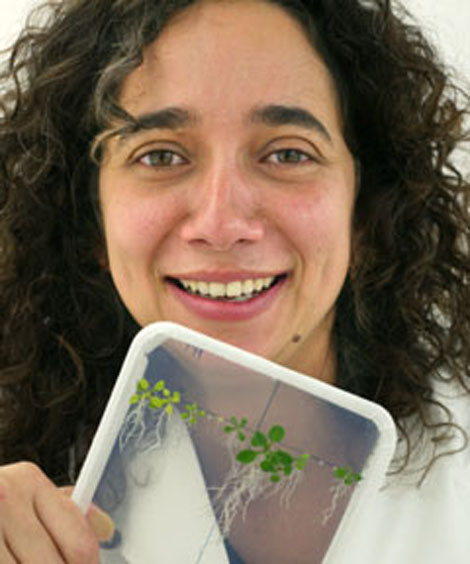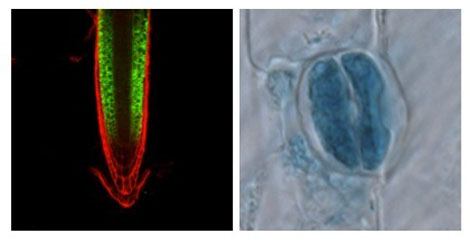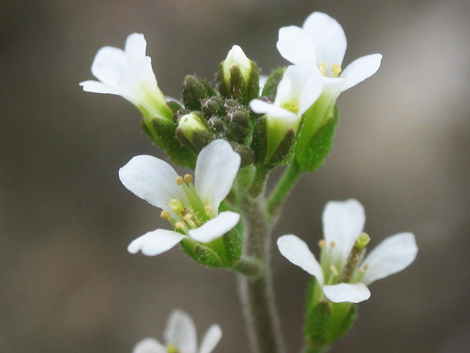 A group of scientists led by Paula Duke. Gulbenkian Institute of Science, discovered a gene that has the particularity of producing two different proteins with completely different location and functions in a model plant.
A group of scientists led by Paula Duke. Gulbenkian Institute of Science, discovered a gene that has the particularity of producing two different proteins with completely different location and functions in a model plant.
The notion that each gene codes for only one protein began to be questioned a few years ago. However, the biological consequences of genes encoding more than one protein are still largely unknown.
Now, in a study published in the most recent issue of the journal “The Plant Cell”*, a group of scientists led by Paula Duke, from the Gulbenkian Science Institute (IGC, Portugal), discovered a gene – ZIFL1 – which has the particularity of producing two different proteins with completely different locations and functions in the plant.
The researchers observed that, in the root, ZIFL1 encodes a protein that is important for the transport of auxin, a hormone essential for the correct growth and development of the plant. However, in leaves, the same gene gives rise to a protein that confers drought tolerance. The gene presented in this study is one of the few identified capable of producing two proteins with such different biological roles.
 ZIFL1 belongs to a family of transporter genes that exists in all classes of organisms, although the function of most of its members is unknown. It is known, however, that these transporter genes encode proteins that are integrated into cell membranes and act by allowing small molecules to pass through them.
ZIFL1 belongs to a family of transporter genes that exists in all classes of organisms, although the function of most of its members is unknown. It is known, however, that these transporter genes encode proteins that are integrated into cell membranes and act by allowing small molecules to pass through them.
Using genetic and cell biology studies in the model plant Arabidopsis thaliana, Paula Duque's team was able to study the role of the ZIFL1 gene. The researchers were surprised to find that mutant plants unable to produce the ZIFL1 transporter had specific defects in different organs and functions.
On the one hand, its roots had problems with growth, branching and orientation when compared to normal plants, which suggested the involvement of the ZIFL1 gene in the transport of auxin, an important hormone for root development. But the researchers also found that the mutant plants had problems resisting water shortages.
They observed that the pores of the leaves that regulate transpiration – the stomata – were more open in mutants than in normal plants, resulting in greater water loss. This suggested that the ZIFL1 gene also played a role in closing the stomata and controlling water loss by the plant, which can be critical in drought conditions.
Intrigued by these observations, the scientists investigated whether the ZIFL1 gene could give rise to two different proteins that would act differently in different tissues. O splicing Alternative is a key mechanism that allows the same gene to produce multiple proteins.
When genes are activated to make proteins, they first give rise to an intermediate RNA molecule that can be processed in different ways, with some portions being removed. This “cut and sew” process can lead to different RNA molecules that can then be converted into different proteins.

Estelle Remy, a researcher in Paula Duque's laboratory and the first author of this work, observed that in the case of the ZIFL1 gene, the splicing alternative yields two RNA molecules that only differ in two chemical residues. However, this small difference has a big impact on the proteins generated, with one of them being shortened by 67 amino acids.
In collaboration with the group of Isabel Sá-Correia at the Instituto Superior Técnico, researchers tested the activity of the two proteins in yeast cells and found that they both carry potassium ions.
The two proteins having different sizes but similar transport activity, Estelle sought to discover what caused them to perform such different biological functions. Surprisingly, he observed that the root tissues had only the long form of the protein, while the short form was present only in the leaves. Furthermore, the location of these two proteins also diverged within the root and leaf cells, being integrated in different cell membranes.
According to Estelle, “the fact that we don't find both proteins in either roots or leaves suggests that these tissues contain specific factors that somehow influence the splicing of ZIFL1 RNA to produce the shape that confers biological function. necessary for that fabric”.

Says Paula Duque: “As far as we know, there aren't many cases of proteins encoded by the same gene that have such different biological functions. What is most fascinating is how the inclusion or removal of just two chemical residues in the RNA molecule results in the production of two proteins that play essential roles in hormone transport or drought tolerance.”
O splicing Alternative is a crucial mechanism for generating protein diversity. In humans, about 20 to 000 genes encode proteins. However, recent studies indicate that more than 25% of these genes suffer splicing alternative, scientists estimate that there may be 500 or more different proteins in the human body.
This study was carried out at the IGC in collaboration with the research groups of Isabel Sá-Correia (Group of Biological Sciences of IBB/CEBQ, Instituto Superior Técnico, Portugal) and Jiří Friml (VIB/Ghent University, Belgium and Institute of Science and Technology , Austria). It was funded by the Foundation for Science and Technology (Portugal).
Author: Ana Mena (Gulbenkian Institute of Science)
Science in the Regional Press – Ciência Viva
Article reference:
*Remy, E., Cabrito, TR, Baster, P., Batista, RA, Teixeira, MC, Friml, J., Sá-Correia, I., and Duque, P. (2013). A major facilitator superfamily transporter plays a dual role in polar auxin transport and drought stress tolerance in Arabidopsis. Plant Cell 10.1105/tpc.113.110353.
Additional information:
RNA – Ribonucleic acid (RNA or RNA) is a molecule that plays a vital role in all organisms. Among other functions, it is involved in transmitting genetic information that directs protein synthesis. Its chemical composition is similar to that of DNA (or DNA), being made up of a strand of chemical residues called nucleotides, but RNA is generally single-stranded (while DNA is double-stranded).
Arabidopsis thaliana (or simply Arabidopsis) is a small plant native to Europe, Asia and northwest Africa widely used as a model organism in Plant Biology and Genetics. Its genome is one of the smallest among plants that produce flowers and was the first genome of a plant to be sequenced.


















Comments